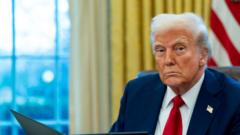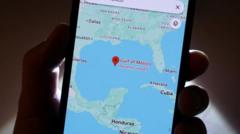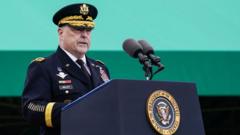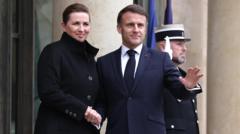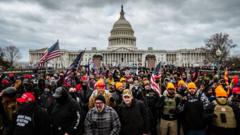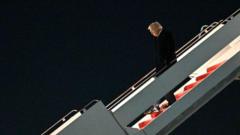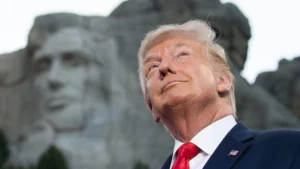In the aftermath of a highly scrutinized election, Kamala Harris' campaign leaders are disclosing insights regarding the disjunction between public polls and their internal analysis, revealing significant challenges leading up to Election Day.
Harris Campaign Reflects on Election Discrepancies: A Closer Look at Internal Polling

Harris Campaign Reflects on Election Discrepancies: A Closer Look at Internal Polling
As public opinion polls diverged from internal data, the Harris campaign sheds light on the challenges faced during the recent electoral race.
As the dust settles on one of the most closely watched elections in recent history, campaign leaders for Kamala Harris are shedding light on why public polls leading up to Election Day didn't match the ultimate outcome. Despite weeks of surveys indicating that Harris had a narrow lead over former President Donald Trump, internal data consistently told a different story.
David Plouffe, a senior adviser to the Harris campaign, recently opened up on the Pod Save America podcast, making it clear that internal polls showed a race much tighter than what was reflected in public surveys. “We didn’t get the breaks we needed on Election Day,” Plouffe admitted, adding that the campaign was never genuinely ahead of Trump in their private polling. “I think it surprised people because there were these public polls that came out in late September, early October, showing us with leads that we never saw.”
The gap between public perceptions and internal reality proved to be a relentless hurdle for the Harris team. Jen O’Malley Dillon, the head of the campaign, discussed their internal polling, which remained static from the moment Harris declared her candidacy in July, describing it as a “margin-of-error race.” She emphasized that they always anticipated a very close contest.
Other campaign leaders shared these insights, recognizing early warning signs that painted a daunting picture. Quentin Fulks, deputy campaign manager, and Stephanie Cutter, who was responsible for messaging and communications, pointed to critical battleground states like Florida and Virginia. Their analysis indicated that Florida's Republican surge and Virginia's unexpectedly tight results presented challenging obstacles in vital regions.
While public opinion polls initially seemed to show Harris gaining momentum following her August entry into the race, Plouffe noted that this optimism wasn’t reflected internally. “It gave a false sense of security,” confided one campaign strategist, attributing this to media narratives driven by the public polling numbers. The combination of unrealistic expectations and the real challenges in Republican-dominated areas led to a lack of surprises when Election Day results departed from previous forecasts.
In retrospect, Harris campaign leadership views the race as an unlikely win from the outset. Despite her initial entrance rallying Democratic voters, insiders acknowledge that the hurdles were deeply rooted and too significant to surmount. As Dillon succinctly stated, “We went in knowing this would be a fight down to the wire—and the margins just weren’t on our side.”
David Plouffe, a senior adviser to the Harris campaign, recently opened up on the Pod Save America podcast, making it clear that internal polls showed a race much tighter than what was reflected in public surveys. “We didn’t get the breaks we needed on Election Day,” Plouffe admitted, adding that the campaign was never genuinely ahead of Trump in their private polling. “I think it surprised people because there were these public polls that came out in late September, early October, showing us with leads that we never saw.”
The gap between public perceptions and internal reality proved to be a relentless hurdle for the Harris team. Jen O’Malley Dillon, the head of the campaign, discussed their internal polling, which remained static from the moment Harris declared her candidacy in July, describing it as a “margin-of-error race.” She emphasized that they always anticipated a very close contest.
Other campaign leaders shared these insights, recognizing early warning signs that painted a daunting picture. Quentin Fulks, deputy campaign manager, and Stephanie Cutter, who was responsible for messaging and communications, pointed to critical battleground states like Florida and Virginia. Their analysis indicated that Florida's Republican surge and Virginia's unexpectedly tight results presented challenging obstacles in vital regions.
While public opinion polls initially seemed to show Harris gaining momentum following her August entry into the race, Plouffe noted that this optimism wasn’t reflected internally. “It gave a false sense of security,” confided one campaign strategist, attributing this to media narratives driven by the public polling numbers. The combination of unrealistic expectations and the real challenges in Republican-dominated areas led to a lack of surprises when Election Day results departed from previous forecasts.
In retrospect, Harris campaign leadership views the race as an unlikely win from the outset. Despite her initial entrance rallying Democratic voters, insiders acknowledge that the hurdles were deeply rooted and too significant to surmount. As Dillon succinctly stated, “We went in knowing this would be a fight down to the wire—and the margins just weren’t on our side.”




